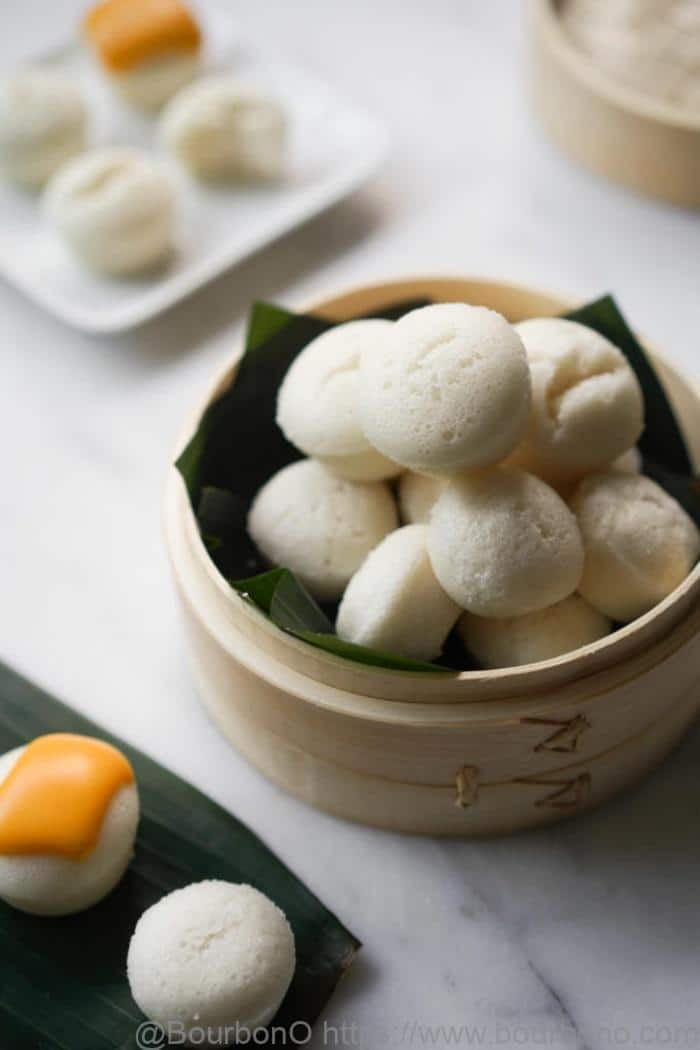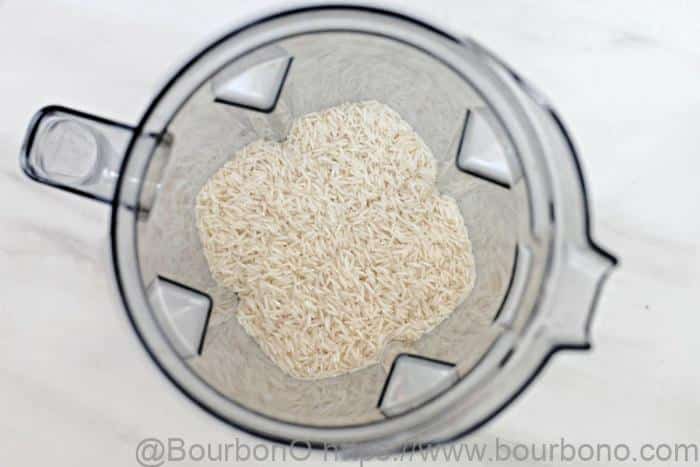Puto Calasiao recipe originates from the province of Pangasinan, more specifically Calasiao town (Philippines). Owing to its popularity, puto calasiao can also be found in Manila. On the freeway to Baguio City, you will see many street vendors who sell this type of Puto. Curious about how to make these colorful little cakes? Let’s dive right into the recipe below!

Puto Calasiao
Puto Calasiao is a type of rice cake (puto) that is made out of fermented rice flour and shaped in bite-size portions. This recipe (as implies the name), originally comes from Calasiao, Pangasinan (Philippines). Puto Calasiao is known as “white gold” of Calasiao as it’s among the town’s economic drivers. There’s also a festival called Puto Festival, which is held annually to celebrate the white rice cake’s native delicacy.
One popular legend tells the story of a poor farmer who stumbled upon the recipe for Puto Calasiao while working in his fields. According to the legend, the farmer found a clay pot containing a piece of paper with the recipe written on it. The recipe called for rice flour, coconut milk, sugar, and a few other simple ingredients. The farmer followed the recipe and made the rice cakes, which turned out to be delicious. He shared the recipe with his neighbors, and it soon became popular throughout the town and beyond.
Another legend tells of a group of travelers who stopped in Calasiao and were offered Puto Calasiao by the locals. The travelers were so impressed with the rice cakes that they asked for the recipe, which the locals gladly shared.
Over time, Puto Calasiao has become an important part of the town’s identity and culture. It is served on special occasions, such as weddings, fiestas, and religious celebrations. It is also commonly sold by street vendors and in local markets.
In this Puto Calasiao recipe, fermentation is the key for best-tasting puto. It is thanks to such a process that the Filipino rice cake can give a unique flavorful punch. The length of time for fermentation varies depending on different techniques. The fermentation process can take up to 3 or 4 days or just 3 hours.
The traditional way to make the puto calasiao is soaking the rice in water and grinding the rice with a blender or a rice milling machine. Once the rice is ground and turns into a sticky texture, it will be fermented in earthenware jars or bowls for a few days.
If you have the opportunity to visit the North of Philippines, don’t forget to stop by the town of Calasiao and have a try of these inexpensive yet delicious goodies. If you’ve been there, you’ll see a street full of tiny stalls that sell many popular Filipino kakanins, including the puto calasiao. In fact, most of the residents in the area sell this cake for a living.
Ingredients of Puto Calasiao
The key ingredients used in making Puto Calasiao are rice flour, coconut milk, and sugar. Rice flour is made from finely ground rice and is the main ingredient in Puto Calasiao. Coconut milk, which is extracted from the grated flesh of mature coconuts, adds richness and flavor to the rice cakes. Sugar is used to sweeten the rice cakes and balance the flavors.
The quality and source of ingredients can affect the taste and texture of Puto Calasiao. Some Puto Calasiao makers use special types of rice flour, such as glutinous rice flour, to create a stickier texture. Others use freshly squeezed coconut milk instead of canned or packaged coconut milk, which can produce a richer and more aromatic flavor. Some Puto Calasiao makers also use brown sugar instead of white sugar, which can add a slight caramel flavor to the rice cakes.
In addition to the basic ingredients, there are also variations or additions to the recipe that can create different flavors and textures. Some Puto Calasiao makers add cheese to the batter, which creates a savory and slightly salty flavor. Others use ube (purple yam) flavoring, which gives the rice cakes a distinctive purple color and a sweet and nutty flavor. There are also versions of Puto Calasiao that incorporate pandan or vanilla flavoring, which add a fragrant and aromatic dimension to the rice cakes.
Useful tips for Puto Calasiao recipe
Puto Calasiao molds
Measure your steamer first before buying any molds. If you want to make sure that the mold you use will fit perfectly in the steamer, then purchase the individual ones. There are some mini silicone liners on Amazon that might work. Otherwise, you can just simply buy a mini silicone muffin mold. Cut the mold in half if it doesn’t fit your steamer.

Speed up the fermentation process
If you make the puto calasiao in the traditional way, it will take up to 3 or 4 days for the fermentation process to complete. If you don’t have enough patience nor time to wait that long, add some yeast in the rice mixture. This is the secret to speed up the fermentation significantly and you’ll only have to wait overnight or at least 8 hours.
Use rice flour
When making Puto Calasiao recipe, you need to use rice flour instead of glutinous rice flour. There’s a huge difference between these two types of flour. Glutinous rice flour can make the puto super dense and sticky, as opposed to the airy and light texture you want.
You may find interesting: How much does 1/4 cup of rice make cooked?
Avoid lumps in the batter
To avoid lumps in the batter, you should sift the rice flour over the liquidy ingredients. This will make your puto calasiao lighter and smoother after steaming.
Steam over medium heat
To avoid drying out or overcooking the puto, steam it over medium heat. Also, make sure the steamer has enough water during the steaming process.
Step by step Puto Calasiao recipe
Ingredients
- Instant yeast (1/2 teaspoon)
- Water (3/4 cup or enough to cover the rice)
- White sugar (1/2 – 3/4 cup)
- Glutinous rice (1/4 cup)
- Jasmine rice (1/2 cup)
Instructions
Step 1
In a container (preferably earthenware bowl for the traditional technique), mix Jasmine rice and glutinous rice. Fill the container with water (enough to cover the rice). Let it soak for about 3 hours.
Step 2
Pour the rice into a blender. Don’t forget to drain the water with a spoon while pouring the rice. Set the water aside.

Turn on the blender and switch to the “liquefy” setting. Pour in water slowly until you obtain a texture that is similar to a batter.
Step 3
Tip in sugar and blend until well combined. Add the yeast and mix well. Cover the mixture using saran wrap and set aside overnight or at least 8 hours. This is when the fermentation process begins. If you don’t use yeast and opt for the traditionally Puto Calasiao recipe, place the mixture in a warm place. This way, it’ll take 3 – 4 days for the fermentation to complete.
More recipe: What does Chamoy taste like? What is it?
Step 4
Cover the puto mold with a thin layer of vegetable oil.
Step 5
The size of the rice mixture will be doubled. Make sure to mix it before pouring into greased molds.
Step 6
Pour in a steamer 8 cups of water and bring to the simmer. Don’t forget to cover the lid of the steamer with water absorbable cloth. This will prevent the water from dripping in the puto and affect its consistency.
Steam the rice mixture for 13 – 18 minutes (for mold size 1/2” in height and 3/4” in width). If you use a bigger size mold, the steaming process will take longer. Insert a toothpick in 2 or 3 of the puto. When pulled out, if the toothpick remains clean then we can say that the rice cake is baked through.

Step 7
Remove the mold from the steamer and let it cool down for roughly 10 minutes.
Step 8
Carefully remove the rice cakes from the mold using a fork or a toothpick. Serve with fresh grated coconut or plain.
Serving and Enjoying Puto Calasiao
Puto Calasiao is a versatile and delicious dessert that can be enjoyed in a variety of ways. It is commonly served with grated coconut, which adds a sweet and nutty flavor that complements the rice cakes. The coconut can be either fresh or desiccated, and can be toasted for added texture and flavor.
Puto Calasiao is also often enjoyed with a hot cup of coffee or cocoa, which provides a rich and comforting contrast to the sweet and light rice cakes. Some Filipinos also enjoy dipping their Puto Calasiao in hot chocolate, creating a decadent and indulgent treat.
Puto Calasiao is typically served on special occasions, such as fiestas, weddings, or family gatherings. It is often presented on a banana leaf or a woven basket, which adds to its rustic and traditional appeal. The rice cakes can be stacked or arranged in a decorative pattern, making them not only delicious but also visually appealing.
In addition to its taste and presentation, Puto Calasiao also holds cultural significance for Filipinos. It is a symbol of hospitality and generosity, and is often shared and enjoyed with family and friends. In some Filipino households, Puto Calasiao is also believed to bring good luck and fortune, and is therefore served during special events and celebrations.
With this Puto Calasiao recipe, we hope you can manage to make this Filipino rice cake at home. Puto calasiao is a very addicting dessert and once you try it, you’ll want to continue munching! You can also add different flavors and colors to the traditional white rice cake to make them more eye-catching. See you in other Bourbono’s interesting food recipes!




